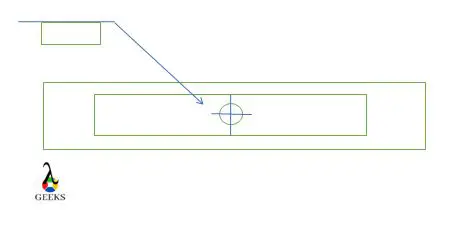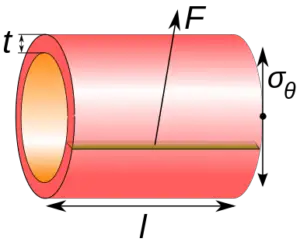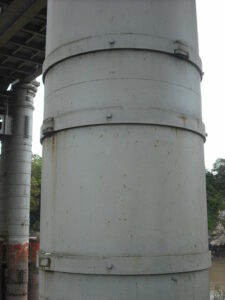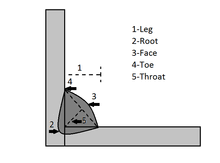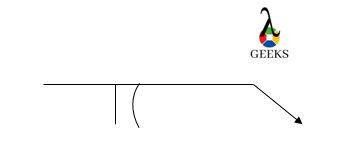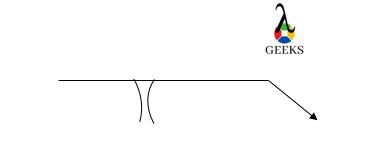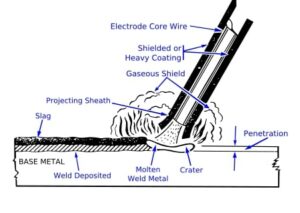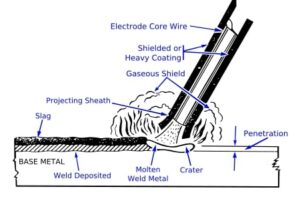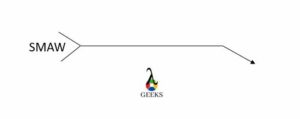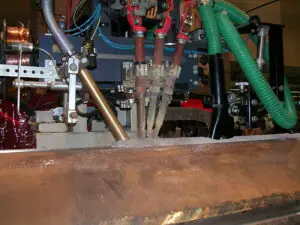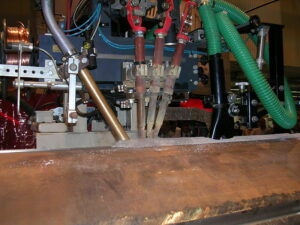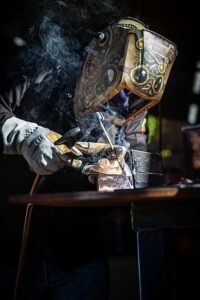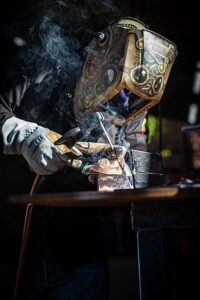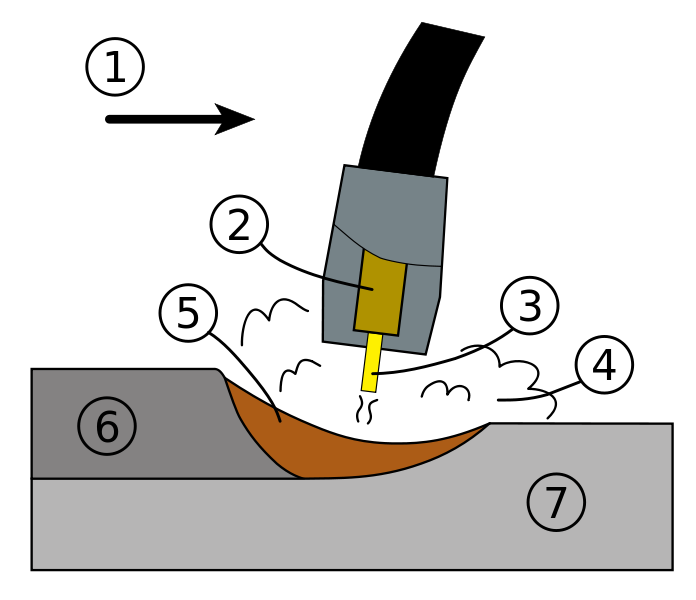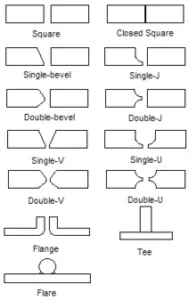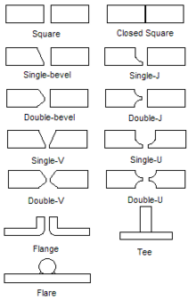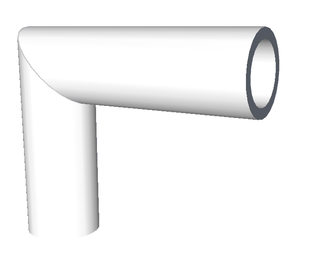In this article, the subject “Plug Weld” with 21 Facts on Plug Weld will be discussing in a brief manner. Plug weld is also known as, Rosette weld.
The welding process of the plug is done when two metals are fused by the welds areas in younger circular holes. The plug weld method is done by the overlapping two metals. When two are overlapped in the top metal hole is created for deposition of the weld.
When spot weld cannot be performing in the metal in that case plug weld is done which can be occurring fairly at every moment.
What is plug weld?
The meaning of the plug weld is a stopper of a gap. Plug welds actually a round shaped weld. In the weld system of the plug two metals are overlapping with each other and a gap is present in one of the metal. The weld is credited in the gap to stop it. The wall of the gaps are remains straight but it is not required. The wall of the gaps can be bended too.
Plug weld symbol:
The symbol of the plug weld is a rectangle with a symbol of diameter situated to the side of the left of the weld symbol same as the number is combined with the symbol of diameter.

Plug welds uses:
At modern engineering fields the plug weld are widely used in various sectors. A welder can easily handle the plug weld with a little exercise and learning. In the automotive sectors and aerospace plug weld is used.
Automotive sector:-
In the automotive sector where heavy machines are need to weld in that case the equipment of spot weld cannot be installed to perform for the insufficient space but as an alternative the plug weld easily can be installed there. The gaps of the machines can be easily welded by the plug weld. The strength of the plug weld is stronger than the spot weld.
Aerospace:-
To fill in the damages in the gaps on the components of the aerospace the plug weld is use. In the gaps of the exit cases and fans preciously filled without scrapping the whole system.
When to use plug weld?
In the sector of the automotive and aerospace where more precious and cleaned welding is require in that case plug weld is used instead of spot welding.
In automotive fields heavy machines are need to weld in that case the equipment of spot weld cannot be installed to perform for the insufficient space but as an alternative the plug weld easily can be installed there.
In the aerospace to filling the holes more accurate welding process is needed in that case plug weld is also used. Accuracy and strength of the plug is more than the spot weld.
Why to use plug weld?
Plug welds are circular shaped welds which are mainly used to corroborate two faces of the metal together by a small size space in one of the faces. In the field of the automotive plug welding is widely used as a substitute of spot welding when the equipment of the spot welding is gets insufficient area to operate.
The strength of the plug welding is more compare to the spot welding.
Plug weld hole size:
The minimum size of the diameter of the hole particularly for the plug should not be less than, the thickness of the part mixed with it plus 5/16(8 mm) ideally rounded to the following higher unaccompanied 1/16″. The highest width shall is same to the minimum width plus 1/8″(3 mm) or 2-1/4 times the thickness of the part, whichever is greater.
Plug weld joint:
In the industrial field with the help of the plug weld in generally five types of joints can be made, they are listed below,
- Edge joint
- Corner joint
- Butt joint
- Lap joint
- Tee joint
Edge joint:-
Edge joint is not applicable for pressure and stress application. Edge joint can be explained as, when two edges of two different parts are joint with each other. The edge joint is appropriate for when the two sheets are adjacent and almost stays at parallel surface at the spot of the welding.
The different types of Edge joints are listed below,
- U groove weld
- V groove weld
- J groove weld
- Bevel groove weld
- Corner flange weld
- Square groove weld
Corner joint:-
Corner joint can be explained as; when two parts corners are situated to form a joint at the angle of right. With the two parts joining the shaped form like L.
The different types of Corner joints are listed below,
- Spot weld
- Bevel groove weld
- U groove weld
- V groove weld
- J groove weld
- Square groove weld
- Fillet weld
- Corner flange weld
- Edge weld
- Flare V groove weld
Butt joint:-
The easiest and simplest joint which is can make by the plug weld is butt joint. The butt joint is created by situated the two parts end section together. The two parts in the butt joint place in the same surface or one after another.
The different types of the Butt joint are listed below,
- Bevel groove weld
- U groove weld
- V groove weld
- J groove weld
- Square groove weld
- Flare bevel groove weld
- Flare V groove weld
Lap joint:-
With the help of lap joint mainly two different thickness metals can be joint with each other. Lap joint can be define as, when two parts are overlapping with each other. Lap joint can be double sided or single sided.
The different types of the Lap joint are listed below,
- Bevel groove weld
- J groove weld
- Slot weld
- Fillet weld
- Spot weld
- Flare bevel groove weld
- Plug weld
Tee joint:-
Tee joint can be explained as, when the two different parts are intersecting with each other at the angle of right and one part is lie at the other at the centre. Tee joint form like T letter.
The different types of the Tee joint are listed below,
- Plug weld
- Bevel weld
- Slot weld
- Fillet weld
- Melt through weld
- Flare bevel weld
- J groove weld
Plug welding thick steel:
The process done with the thick metal in plug welding is listed below,
- Cleaning the thick steel
- Marking on the top the thick steel
- Holes are created on the top of the thick steel
- Place the thick steels together
- Placed the welding
Plug welds design and strength:
The strength of the plug weld is more than comparative to the spot weld. With the plug weld thick metals can be work. The design of the plug weld is not applicable for high force and stress.
How to calculate plug weld strength?
The process for calculating the strength of the plug weld is listed below,
- The weld size and the weld strength are multiply with each other.
- The highest permissible tensile strength is dividing with the above product.
- The resultant should be multiply with the value of 0.77 to get the joint of the weld length.
Plug welding procedure:
The process of the plug welding is done in some steps. The steps are describe in below,
- Step – 1: Cleaning the metal
- Step – 2: Marking on the top metal
- Step – 3: Holes are created on the top metal
- Step – 4: Place the top metal and base metal together
- Step – 5: Placed the welding
Step – 1: Cleaning the metal:-
In the beginning of the plug welding at first the pre preparation is done. In this step the base metal need to clean up thus any dirt or impurities cannot takes place during the welding process and also cleaning is important after the welding method no defect is present. Safety is very important while welding process. Welding gloves, welding helmet, should be wear by the welder to prevent accident. At last welding burn is not desire during the plug welding process.
Step – 2: Marking on the top metal:-
In the next step of the plug welding marking is done on the top section of the base metal. If multiple plugs welding are done in the base metal in that case requires to be spaced out on a level.
Step – 3: Holes are created on the top metal:-
After marking, the holes are created in which places where the plug welding will be created. In the various ways hole can be done in the base metal among them drilling is most common process chosen by the welders to create holes.
Step – 4: Place the top metal and base metal together:-
After completingmarking the metal should be placed together thus they cannot move during the process. A plug weld clamp is use to clamp the metals at one place.
Step – 5: Placed the welding:-
At the last of the process weld is placed. When the welding is placed the most important criteria need to remember that, the process should be start on the external side along the points of the edges, the way of the working will be towards the middle. The strength of the metal will be increases and chances of the defect will be decreases by this process and also the temperature of the base metal is rise up to the temperature of the top metal.
Can plug welds be used in tension?
No, plug welds cannot be used in tension.
The dimensions which are applied for the symbol of the plug weld are listed below,
- Depth of filling
- Size
- Angle of counter stroke
- Number of the welds
- Spacing of the welds
How to plug weld sheet metal?
The process of the plug welding in the sheet metal is done in some steps. The steps are describe in below,
- Cleaning the sheet metal
- Marking on the top the sheet metal
- Holes are created on the top of the sheet metal
- Place the sheet metal together
- Placed the welding
Cleaning the sheet metal:-
In the beginning of the plug welding at first the pre preparation is done. In this step the sheet metal need to clean up thus any dirt or impurities cannot takes place during the welding process and also cleaning is important before the welding method no defect is present.
Marking on the top the sheet metal:-
In the next step of the plug welding marking is done on the top section of the sheet metal. If multiple plugs welding are done in the sheet metal in that case requires to be spaced out on a level.
Holes are created on the top of the sheet metal:-
After marking, the holes are created in which places where the plug welding will be created. In the various ways hole can be done in the base metal among them drilling is most common process chosen by the welders to create holes. Mostly 8 mm – 10 mm hole is doing. The hole diameter depend on the flange width and the distance keep between the holes are near about 25 mm.
Place the sheet metal together:-
After completingmarking the metal should be placed together thus they cannot move during the process. A plug weld clamp is use to clamp the metals at one place.
Placed the welding:-
At the last of the process weld is placed. When the welding is placed the most important criteria need to remember that, the process should be start on the external side along the points of the edges, the way of the working will be towards the middle. The strength of the metal will be increases and chances of the defect will be decreases by this process and also the temperature of the base metal is rise up to the temperature of the top metal.
Plug weld vs. slot weld:
The major differences in between the plug weld and slot weld are describe below,
| Plug weld | Slot weld |
| A weld made in a circular hole in one member of a joint fusing that member to another member. A fillet-welded hole is not to be construed as conforming to this definition. | A slot weld joins the surface of a piece of material to another piece through an elongated hole. The hole can be open at one end and can be partially or completely filled with weld material. |
| The shape of the plug weld can be identified with the help of diameter. | The shape of the slot weld can be identified with the help of the both length and diameter. |
| Application of the plug weld is, 1. Manufacturing the body of the automotive 2. Repairing the body of the automotive 3. Welding tubes inside a pipe 4. To join different thickness metal | Application of the slot weld is, 1. Dispatch the shear force in lap joints 2. Stopping buckling in overlapped portions. |
Puddle weld vs. plug weld:
The major differences in between the plug weld and puddle weld are describe below,
| Plug weld | Puddle weld |
| The welding process of the plug is done when two metals are fused by the welds areas in younger circular holes. | A type of plug welds for joining two sheets of light-gauge material; a hole, burned in the upper sheet, is filled with a puddle of weld metal to fuse the upper sheet to the lower. |
| Thick material can work with the plug weld. | Thick material could not work with puddle weld. |
Plug weld vs. spot weld:
The major differences in between the plug weld and spot weld are describe below,
| Plug weld | Spot weld |
| The welding process of the plug is done when two metals are fused by the welds areas in younger circular holes. The plug weld method is done by the overlapping two metals. When two are overlapped in the top metal hole is created for deposition of the weld. | Spot welding process can be explain as, welding together two or more than two metals with the help of heat and pressure into the area of the weld from an electric current. |
| The strength of the plug weld is more than the spot weld. | The strength for the spot weld is comparative less than the plug weld. |
| Technical cost is low. | Technical cost is high. |
| Accuracy of the plug weld is more. | Accuracy of the spot weld is less comparative to the spot weld. |
| For the repairing of the automotive body panel plug weld is used. | For the assembly of the automotive body panel spot weld is used. |
Necessity of space in plug socket weld:
With the help of space between the two plates in the plug socket weld the quality of the weld can be easily determine. If gap is present in between two plates then it’s called good plug socket weld and if gap is not present in between two plates then it’s called bad plug socket weld.
The space of the plug socket weld is used to minimize the crakes while the plates are gets warmer to absorb the excess amount of temperature during the welding process.
Conclusion:
If skilled welder with a little learning can work with plug weld then it is very advanced and suitable process to weld. The strength of the plug weld is good enough to weld.
